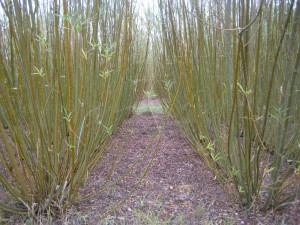 SRC consists primarily of densely planted, high yielding varieties of willow, and occasionally poplar, harvested on a two to five year cycle, although most commonly every three years. The rootstock or stool is left in the ground and after each harvest new shoots emerge, as in traditional coppice. It is currently expected that an SRC plantation should be viable for 30 years before it needs replanting.
SRC consists primarily of densely planted, high yielding varieties of willow, and occasionally poplar, harvested on a two to five year cycle, although most commonly every three years. The rootstock or stool is left in the ground and after each harvest new shoots emerge, as in traditional coppice. It is currently expected that an SRC plantation should be viable for 30 years before it needs replanting.
SRC costs around £2500 per hectare to establish. It can be grown on marginal and reclaimed land although a reduction in yield should be expected in these circumstances. Harvesting takes place during the winter and therefore provides employment opportunities for agricultural workers at a quiet time of year. However, as it is a perennial crop with reduced requirements for pesticide application or other annual arable operations it has a lower labour requirements overall compared to other arable crops.
| Pros | Cons |
| Low inputs required. | Limited availability of machinery – mostly in the North of England |
| Higher returns than miscanthus | Harvested every three years – so poor initial cash flow |
| Reduces fixed costs of the farm | Lots of pests and disease (although countered to great extent by mixtures of diverse varieties) |
| Mixed plantations so not a monoculture | Mixed plantations can be a problem to harvest |
| Some fields harvested each year therefore a patchwork effect | For best quality fuel needs reprocessing which is expensive |
| Excellent for biodiversity – birds and insects | High moisture content when harvested |
| Wide range of boilers suitable for processed fuel | Large storage area required – typically outside |
| Responds well to N fertilizer | Some forms (i.e. chips) will lose yield due to composting during storage |
| Can be planted on more marginal land | Decommissioning of site is more difficult than miscanthus |
| Can affect land drains |